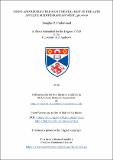Files in this item
Using and reusing the monumental past in the late antique Mediterranean West, 300-600
Item metadata
| dc.contributor.advisor | Woolf, Greg | |
| dc.contributor.advisor | Lavan, Myles | |
| dc.contributor.author | Underwood, Douglas R. | |
| dc.coverage.spatial | xii, 381 p. | en_US |
| dc.date.accessioned | 2015-08-25T13:43:05Z | |
| dc.date.available | 2015-08-25T13:43:05Z | |
| dc.date.issued | 2015-06-15 | |
| dc.identifier.uri | https://hdl.handle.net/10023/7323 | |
| dc.description.abstract | Scholarship on late antique cities has largely conceptualized them as singular entities, either decaying or transitioning as Roman imperial power and economic structures shifted. Improved archaeological data from urban sites, accompanied by a number of broad synthetic studies, now allow for fresh exploration of the details of urbanism in this transformative era. This study examines the ways that a select group of public buildings were used and reused in the Mediterranean West between 300 and 600 CE. This examination is primarily carried out through the collection of a broad catalogue of archaeological evidence (supplemented with epigraphic and literary testimony) for the constructions, work projects, abandonments and reuses of key public monuments across the Western Mediterranean region—principally Italy, southern Gaul, Spain, and North Africa west of Cyrenaica. This broad survey is augmented with case studies on select cities. Such an analysis of the late antique histories of baths, aqueducts, and spectacle buildings (theaters, amphitheaters, and circuses) shows that each of the building types had a distinct history and that public monuments were not a unitary group. It also reveals unexpectedly few regional trends, suggesting that these histories were broadly common across the West. Further, this study shows that each building type was reused differently, both in terms of purposes and chronology. Finally, by considering economic, technological, cultural and legal factors affecting patterns of use, abandonment and reuse, this study establishes that the primary cause for the transformations to public building was largely a change in euergetistic practices in late antiquity. Cities with access to imperial or other governmental patronage used and maintained their public monuments longer than those without. Together these observations demonstrate the complexities of urban change in this period and prove that the idea of a single pattern of decline in late antique cities is no longer tenable. | en_US |
| dc.language.iso | en | en_US |
| dc.rights | Creative Commons Attribution-NonCommercial-NoDerivatives 4.0 International | |
| dc.rights.uri | http://creativecommons.org/licenses/by-nc-nd/4.0/ | |
| dc.subject | Late antiquity | en_US |
| dc.subject | Public monuments | en_US |
| dc.subject | Urbanism | en_US |
| dc.subject | Baths | en_US |
| dc.subject | Spectacles | en_US |
| dc.subject.lcc | HT114.U8 | |
| dc.subject.lcsh | Public buildings--Mediterranean Region--History | en_US |
| dc.subject.lcsh | Cities and towns, Ancient--Mediterranean Region | en_US |
| dc.title | Using and reusing the monumental past in the late antique Mediterranean West, 300-600 | en_US |
| dc.type | Thesis | en_US |
| dc.type.qualificationlevel | Doctoral | en_US |
| dc.type.qualificationname | PhD Doctor of Philosophy | en_US |
| dc.publisher.institution | The University of St Andrews | en_US |
| dc.identifier.doi | https://doi.org/10.17630/10023-7323 |
This item appears in the following Collection(s)
Except where otherwise noted within the work, this item's licence for re-use is described as Creative Commons Attribution-NonCommercial-NoDerivatives 4.0 International
Items in the St Andrews Research Repository are protected by copyright, with all rights reserved, unless otherwise indicated.


